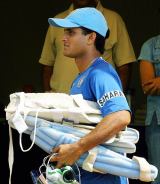Mixed signals
Among the inconsistencies in Friday's selection is a clear message to Sourav Ganguly that he must deliver in the Tests
Anand Vasu
20-Apr-2007
|
|

|
After much excitement and an extended build-up, the selection committee
indicated, rather gently, that there was a way for an Indian team to
not contain Sachin Tendulkar and Sourav Ganguly. Though it's unclear
just how much can be read from omissions and inclusions for what is
essentially a three-week tour to Bangladesh, the decisions taken today send out mixed signals and seem to deviate from the Board of Control for Cricket in India's directive to pick a "young team" under Rahul Dravid.
Amid the mixed signals, though, is a clear message to Ganguly: His one-day career is all but over, though he may have some Tests left in his bag. It has emerged that the selectors, and senior members of the board, are far from impressed with Ganguly's recent ODI performances. His 129-ball 66 against Bangladesh, 114-ball 89 against Bermuda, and 23-ball 7 against Sri Lanka conveyed the impression that he was more concerned with making runs for himself than the team.
However, to have dropped Ganguly without also leaving out other cricketers who failed to perform would have left the selectors with some uncomfortable questions to answer. To that end they gave themselves some room to manoeuvre, "resting" Tendulkar and "dropping" Harbhajan Singh.
Of all three high-profile omissions, it seems that Ganguly is the one whose future is at risk. Is this the end of the road for him? Dilip Vengsarkar, the chairman of
selectors, said emphatically that Tendulkar and Ganguly would be considered in the future but a young batsman taking the chances afforded to him could well make it difficult for Ganguly to return. After all, with no domestic cricket left to prove his form in, Ganguly will be under intense pressure to score in the Tests against Bangladesh. A couple of failures there and he might well be out in the cold.
It's definitely not the same with Tendulkar; though he had a pretty miserable time in the World Cup, it is clear he has been rested only because it would have been impossible otherwise for the board to omit Ganguly. The difference between the cases of Ganguly and Tendulkar in the longer term is that the concern over Tendulkar's form is purely cricketing. In the case of Ganguly, however, members of the board and the selection committee are convinced - and they are privy to information that the public at large is not - that he was not always batting with the team's best interests at heart.
That brings up the case of Harbhajan Singh. Although he has been the one-day spinner of choice for some time now, he has not played the role of the champion offspinner that was expected of him.
In recent times his performances have fallen away and
the fact that he is somewhat reluctant to bowl his doosra as often as
before - it is possible some officials have had a quiet word with him about the trouble it could get him into in terms of his action - has made him a far less potent force. The advantage Harbhajan has, however, is a lack of serious competition from spinners on the domestic circuit, and that that, at 26, he has age on his side.
|
|

|
On the issue of youth, though, the message is not as clear. The one-day team has two fresh youngsters in Piyush Chawla (18) and Manoj Tiwary (21), but there is also place for Dinesh Mongia. After playing 55 ODIs spread over seven years Mongia has not been able to cement a place in the team. He's had one defining innings, an unbeaten
159, and that came against a fairly weak Zimbabwe team at home in
2002. Since then he has been in and out of the side, and for him to be
picked - the logic being that left-handed batsmen would be a bonus against
Bangladesh's three left-arm spinners - is not really a step forward.
The case of Rajesh Pawar, who has no doubt had a good season, is similar.
Though still relatively young at 27, he has played 10 seasons of
domestic cricket, and for the selectors to plump for someone who has
bloomed so late suggests that they might have closed the door on Murali
Kartik. In all fairness to Kartik, he's been out of the Indian team through
injury and, since the Zimbabwe tour in 2005, has played
with serious pain in his left shoulder.
Kartik (30) did make a strong comeback to domestic cricket, walking into the final of the C & G Trophy for Lancashire and picking up a couple of wickets as his side won. However, he was not among the 30 World Cup probables. If the current exercise was aimed at going for youth then the selectors could have opted for Pragyan
Ojha, the young Hyderabad left-arm spinner, or even punted all the way and
picked Karnataka's KP Appanna.
The selection committee had many tricky choices to make, mostly at the
policy level - youth or experience? Long-term planning or short-term
gains? They haven't quite nailed that down, but they have made it clear
that they are not going to be dictated to by the players. Had Dravid
gotten his way, Ajit Agarkar might well have found his way into the one-day team, Ajit Agarkar into the Test side - along with, perhaps, Virender Sehwag.
Anand Vasu is associate editor of Cricinfo

